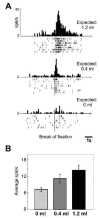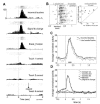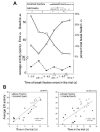Anterior cingulate error-related activity is modulated by predicted reward
- PMID: 16026482
- PMCID: PMC1913346
- DOI: 10.1111/j.1460-9568.2005.04170.x
Anterior cingulate error-related activity is modulated by predicted reward
Abstract
Learning abilities depend on detection and exploitation of errors. In primates, this function involves the anterior cingulate cortex. However, whether anterior cingulate error-related activity indicates occurrence of inappropriate responses or results from other computations is debated. Here we have tested whether reward-related parameters modulate error-related activity of anterior cingulate neurons. Recordings in monkeys performing stimulus-reward associations and preliminary data obtained with a problem-solving task revealed major properties of error-related unit activity: (i) their amplitude varies with the amount of predicted reward or the proximity to reward delivery; (ii) they appear both after execution and performance errors; (iii) they do not indicate which error occurred or which correction to make; and (iv), importantly, the activity of these neurons also increases following an external signal indicating the necessity to shift response. Hence, we conclude that anterior cingulate 'error' activity might represent a negative deviation from a predicted goal, and does not only reflect error detection but signals events interrupting potentially rewarded actions.
Figures



References
-
- Amiez C, Procyk E, Honore J, Sequeira H, Joseph JP. Reward anticipation, cognition, and electrodermal activity in the conditioned monkey. Exp Brain Res. 2003;149:267–275. - PubMed
-
- Brooks VB. How does the limbic system assist motor learning? a limbic comparator hypothesis. Brain Behav Evol. 1986;29:29–53. - PubMed
-
- Brown JW, Braver TS. Learned predictions of error likelihood in the anterior cingulate cortex. Science. 2005;307:1118–1121. - PubMed
-
- Fiorillo CD, Tobler PN, Schultz W. Discrete coding of reward probability and uncertainty by dopamine neurons. Science. 2003;299:1898–1902. - PubMed
-
- Gehring WJ, Goss B, Coles MG, Meyer DE, Donchin E. A neural system for error detection and compensation. Psychol Sci. 1993;4:385–390.
Publication types
MeSH terms
LinkOut - more resources
Full Text Sources
Other Literature Sources

